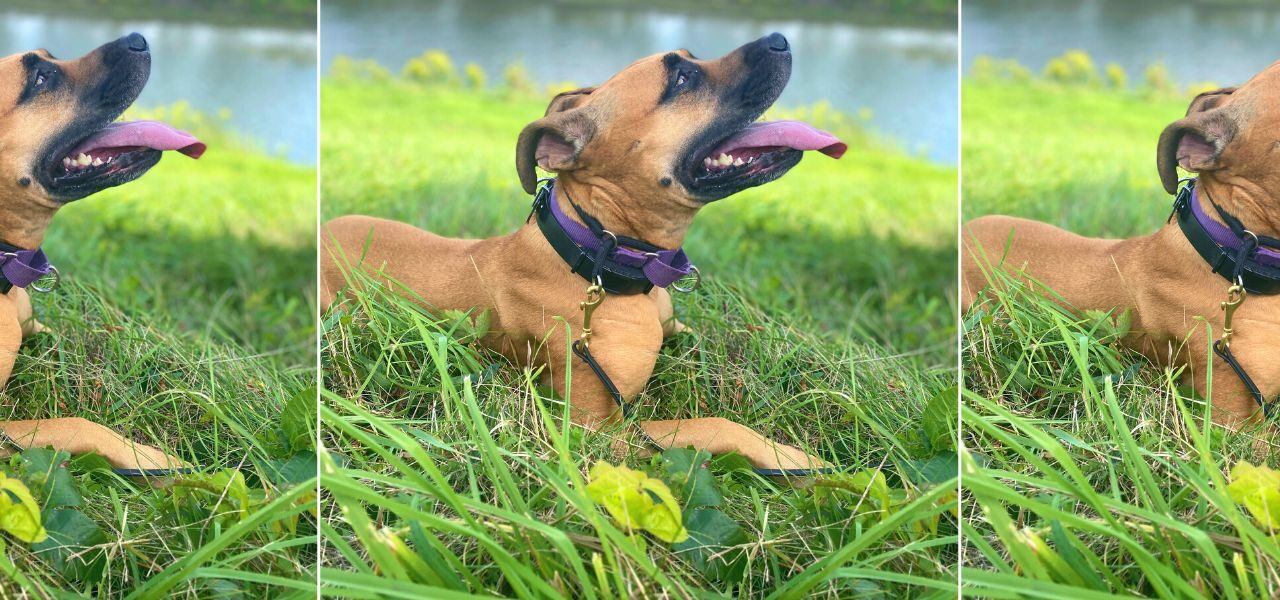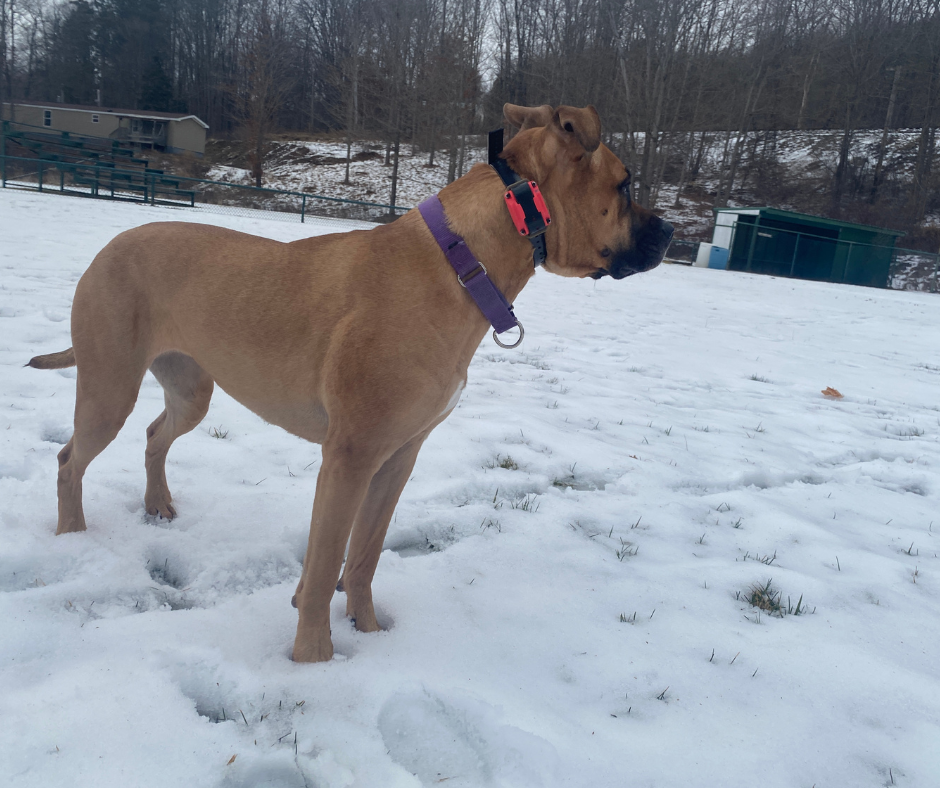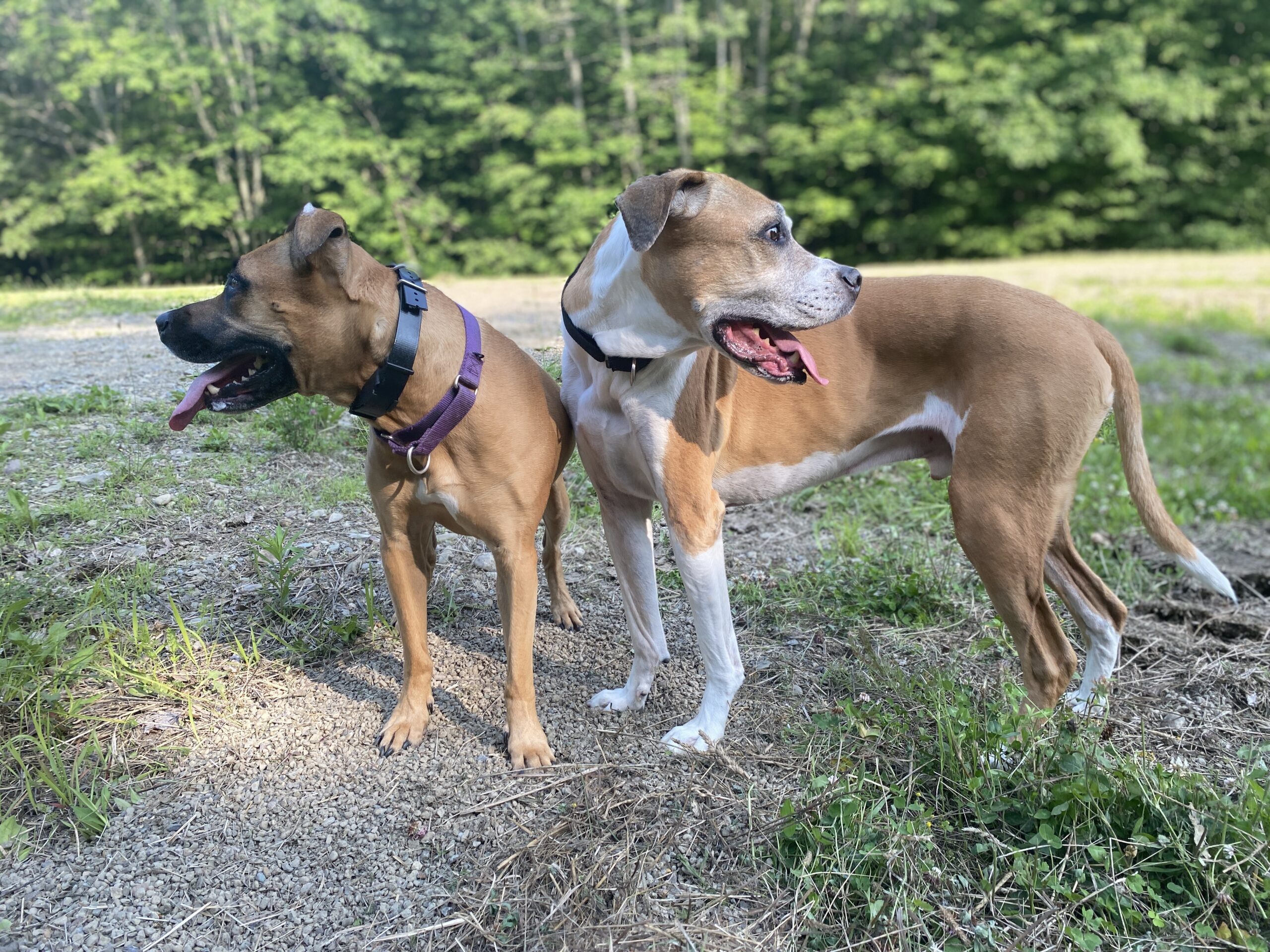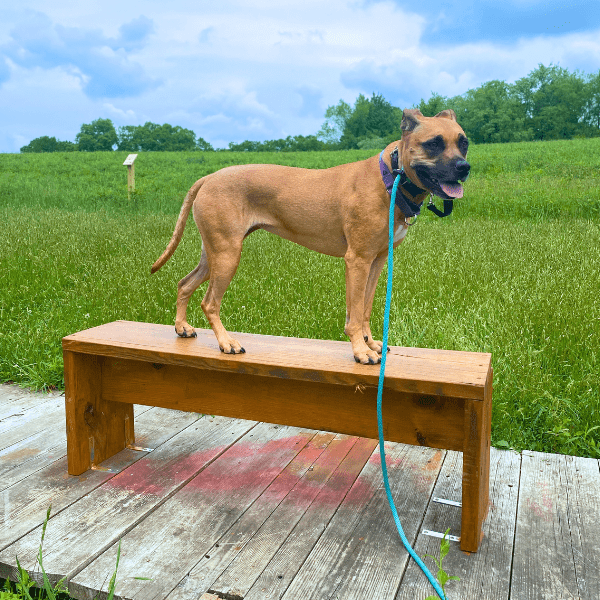
This post is all about using an e collar for dog training. An e collar can give you and your dog more consistency, freedom, and quality of life.
When I first saw trainers using e collars on youtube, I was instantly interested! Yet, also equally terrified. I knew this tool could help my dog, but I didn't want to use it wrong and do further damage.
Since then, I've not only mastered the ecollar with my own dog, but also helped hundreds of dog owners help their own dogs with an e collar.
In this post, you'll learn the basics of using an e collar for dog training, specifically how to use your collar for shaping obedience.

Using an E Collar for Dog Training
Ecollar for Dogs
As technology evolves, dog training also evolves. Many people are familiar with shock collars, which deliver a tone, vibrate and electric shock by a remote. There's a few reasons this type of collar is outdated and old school.
For the sake of sticking to the topic of this article, we won't spend much time trying to sell you on an ecollar (you've already clicked on this article, so you probably don't need convincing.)
The only collars that Liggett Dog Training uses are the Educators and Dogtra. (Our personal favorite is the Dogtra ARC).
Related: Best Shock Collar | Tom Davis 280C Review
Whatever collar brand you use, you want to make sure you are working with TENS unit stimulation and NOT electric shock. If you paid less than $200 for your collar, it's very likely using electric shock.
And, if you are using electric shock, I don't recommend using the training method outlined in this post.


Beginner E Collar Training
If you are using your e collar for the first time with your dog, then it is a good idea to work with a professional dog trainer who regularly uses e collars.
Don't have a dog trainer? Schedule a consult now to discuss a custom plan for you and your dog!
Once you have picked out the best e collar for you and your dog's goals. It's time to get familiar with your new e collar and it's features. Youtube is a great source for learning exactly what features your collar has.
Lastly, many people are interested in trying the collar for themselves. I definitely recommend for people without a pacemaker to try this! It's such a great thing to really understand what you are doing to your dog.
To try it on yourself, start at level one, and roll up slowly until you start to feel it. No need to test it at 100 or all the way up! You shouldn't use those levels for you or your dog unless it is the lowest effective level.
How tight should the e collar be?
Next, check your dog's e collar for fit. The e collar should be tight enough so that both prongs are touching the dog at all times.
When your dog lowers their head- their neck becomes longer, and therefore smaller in size.
So, make sure you fit your dog's collar correctly and feel the tightness through a few different head positions.
The receiver part of the collar shouldn't move around your dog's neck easily. Set the receiver to one side of the dog's neck. If it quickly falls to the bottom of your dog's neck quickly, the collar isn't tight enough. (This is also why we love the Dogtra ARC).
If you're really struggling to get good contact with the prongs, looking into longer prongs or winged contact points may be a good option. This is especially true if you have a long-haired dog, or a dog with a thick under coat.
The level of your collar will also vary depending on tightness of the collar. A tighter collar will not need as high of a level as a looser collar.
So, be sure to mark the hole on the collar so that you can return it to the same tightness each time.
How to Use an E collar
Now, when it comes to delivering the stim (or what many people might think of as shock) to your dog, there's a few options.
Most dogs do best with utilizing the continuous button. However, there are three main patterns of stimulation that dog trainers like to use. Check your specific e collar remote to understand which button does what.
The first pattern is a single tap. Also known as a "nick" or "momentary" stimulation. The Dogtra 280C has a button with knobs in the shape of an "N" to indicate the nick button. No matter how long you hold the button down in this scenario, the stimulation will only occur once, momentarily.
The continuous is the most common pattern. When you press the continuous, your dog will feel stimulation for as long as you hold the button down- for up to 12 seconds. If you need to have the collar on longer than 12 seconds, you are not working at the correct level. You can also utilize the continuous button as a momentary correction by tapping instead of pressing and holding.
The last pattern is a tap tap hold pattern. This is usually what is used for finding the dog's e collar levels. Some dogs respond better to a higher level nick stimulation pressed repeatedly, while some dogs respond better to a lower level continuous stimulation.
Try these patterns on yourself to get a better idea of what your dog will be feeling!
E Collar Dog Training Obedience
Next, it's time to find your dog's working level. This is where so many people go wrong because they go up too high, too fast.
Pro tip: If you don't have a pacemaker, it's a good idea to try this exact process with yourself first! The TENS stimulation feels a little bit like hitting your funny bone.
When your dog is calm and relaxed, start your collar on level one. Using the continuous button, use the pattern: tap, tap, hold for 3-5 seconds on each level.
Do this until you notice that your dog notices the sensation of the stimulation. (Once you've found your dog's number, you can use the stimulation pattern that works best for them.)
You'll be surprised to know some dogs are delicate flowers about this and only need single digit levels!
Your dog will tell you if they feel the stimulation by looking at the ground, sitting, stop panting, flicking their ear, shaking their head, looking like they're watching a fly, or even scratching their neck.
If you're not sure if your dog feels the stimulation, stay at that level for a little bit before moving up.
At no point should your dog be twisting their head or vocalizing. If this happens, forgive yourself, and lower your collar stimulation by at least half, and start over in finding your levels.
The important thing to keep in mind when finding these working levels is that your collar has 127 levels. Do not get hung up on the actual number- look for what works with your dog.
Most dogs will respond around a level 4-20. However, some dogs need higher levels due to genetics, personality, environment, previous collar use, or their individual situation.
Positive E Collar Training
We want to keep the collar on a setting that allows the dog to still think through their response rather than just react to the stimulation. If your dog is treat or toy motivated, the e collar shouldn't take away their ability to work for treats or play with toys.
No matter what kind of training you are doing with your dog or what kind of tools you are using, your dog must look better and happier at the end of the training sessions than at the beginning.
E collar training may feel like you're not doing anything or that your dog "isn't feeling it". But, over the course of a 5-10 minute obedience training session you should see your dog start to respond quicker.
How do you train commands with an e-collar?
You want your dog to love training with the ecollar. Whenever we add pressure- even if it's a level 2/127, it's important to offer your dog a solution to the pressure. So, just because we have the e collar on, doesn't mean we unclip the leash.
The leash is your translator.
Read that again.
The easiest way to teach the dog e collar skills is by pairing the e collar with things your dog already understands. For example, pair the e collar with the "sit" command.
Let's say your dog's name is Bella. Here's the formula you'd use in order to teach Bella about the ecollar:
"Bella, sit" pause. "Bella, sit" pause. Ecollar is turned on.
When your dog sits, then the formula stops progressing.
What to do if dog doesn't listen to e collar
If your dog doesn't sit or lay down, chances are they don't know the command as well as you thought they did. Go back and practice with distance, duration and distraction.
Related: Teaching a Dog to Sit (So They Actually Listen the First Time)
Remember, the leash is your translator.
If your dog doesn't immediately sit, then help your dog find the sit by using a treat to guide them or the leash to guide them into a sit position. The e collar stimulation should not be so much that your dog ignores the treat. If they are more concerned with the collar stimulation than the treat, come down on your e collar stimulation level.
When your dog does get out of the sit before you've given your release command, the collar stimulation should be on, and you should be helping your dog to find their sit again.
If you use this formula- eventually, your dog will listen at the first "Bella, Sit" command.
Similarly, if your dog jumps up out of the sit when they feel the collar, or they start to look discouraged- you'll need to lower your ecollar level, and go back to teaching sit with distance, duration and distraction.
E Collar Training Pros and Cons
Using an ecollar for dog training has it's pros and cons. The biggest pro is that the collar offers a way to smooth and speed up dog training when used correctly. The biggest set back and mistake is that people can move too fast with training.
Just because you have a tool that works, doesn't mean you can throw any distraction at your dog.
E Collar Training for Reactive Dogs
When it comes to using the ecollar for behavior modification or intervening in unwanted behavior, it's best to chat with a professional trainer.
The formula for reactive dogs is very similar. Usually, this is paired with a "Bella, Leave it." Pause. "Bella, Leave it" and then the ecollar comes on to correct the behavior at an appropriate level- this may or may not be your obedience level.
Related: Contact a professional dog trainer today to ask about your dog's behavior
However, there are some behaviors that just need to be corrected like mouthiness, jumping up on people, counter surfing and ankle-biting.
To correct these behaviors, you would just turn the e collar on when the dog does the behavior and then off as soon as they stop. These levels can be a little harder to find and are often greater than your "obedience" or "working level" on the e collar.
Related: 3 Proven Methods for How to Stop Dog Jumping Up
Even with intervention e collar use, you want to make sure you are not taking your dog's ability to think through their choices. You do not want them just reacting to the e collar, but beginning to make better choices.
E collar Dog Training FAQ's
1) Should I leave my dog's e collar on all the time?
When you start e collar training, your dog should wear the collar anytime you may ask for the command that you're pairing the ecollar with. This usually means they wear the collar all the time. The collar comes off if you are not home, or if the dog is in the crate.
If you say the command, but don't follow up with the e collar, the dog will start to become collar aware and stop listening to you, and begin to listen to the collar.
*In my opinion,* I don't really care if my dog develops collar awareness, since we only use the collar in specific situations. However, many people don't want to rely on the collar forever, so the more your dog wears it, the less they'll become aware of it and you can wean them off of the collar.
2) The e collar is not working.. what next?
The very first thing to check is to make sure the collar and the remote is on and charged. Check for a green blinking light or check the vibrate so you can make sure the remote and receiver are paired together.
Next- check to make sure the tightness is appropriate for your dog. Check to make sure that you're using the appropriate sized prongs. If your dog has long hair, you may want to consider shaving a spot for the prongs or investing in longer prongs.
If you're worried the stimulation isn't working- try it yourself!
Lastly, if you've checked all these things and have all green lights, we probably just need to go up in levels! That's why Dogtra makes collars with 127 levels- so you can go up if you need to.
You always want to use the lowest effective level. If the level isn't effective, we need to move up.
3) When to use e collar vibrate for dog training?
There are many ways to utilize the vibrate tone for dog training. Most dogs do not need the vibrate button.
This is because the vibrate can often be more startling and freak some dogs out. The vibrate can often be more aversive to your dog than the low level stimulation.
Other dogs blow right through the vibrate and don't even care. Then there are some dogs in the middle, where it works at first, but then owner's over use it and the dog gets used to it.
I do not recommend using the vibrate button for this reason.
Some trainers will even pair the vibrate as a "good" or "yes" marker with deaf dogs as well- showing that for most dogs, it really doesn't bother them as an aversive.
Overall, skip the vibrate button unless your trainer tells you it's a good idea.
4) When to use a tone for dog training?
This is why Dogtra is the preferred brand at Liggett Dog Training- there's no tone. Having a tone would tempt dog owners to use it, and in the pet dog world, there's usually not a need for it.
The tone is your audible cue, which is usually then followed up by something else. The audible cue should be your voice, which is then followed up by the stimulation.
This is not always the case if you decide to do hunting or other sports with your dog where your dog may be out of earshot. However, most pet dog owners should skip the tone, and just follow up their vocal command with the e collar stimulation.
5) I just show the dog the remote and then he listens. Is that okay?
If that system works for you, then sure.
However, if you want to carry the remote around with you forever be very careful about using this method.
Ideally, the dog won't see the remote all of the time. Practice keeping the remote in your hoodie pocket or behind your back.






